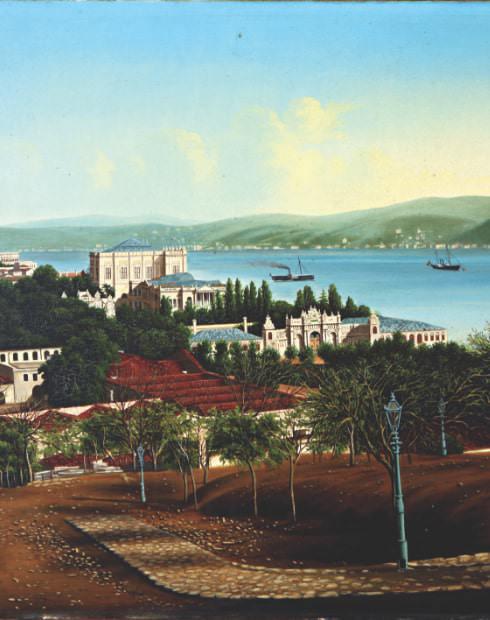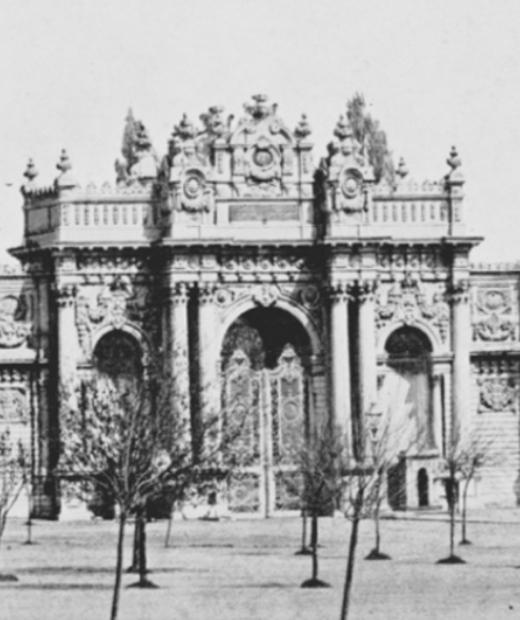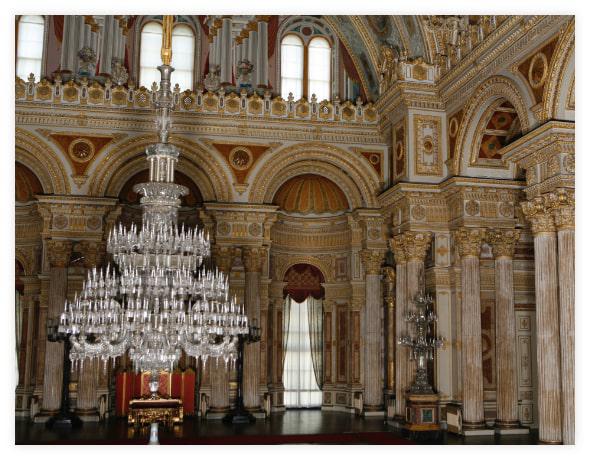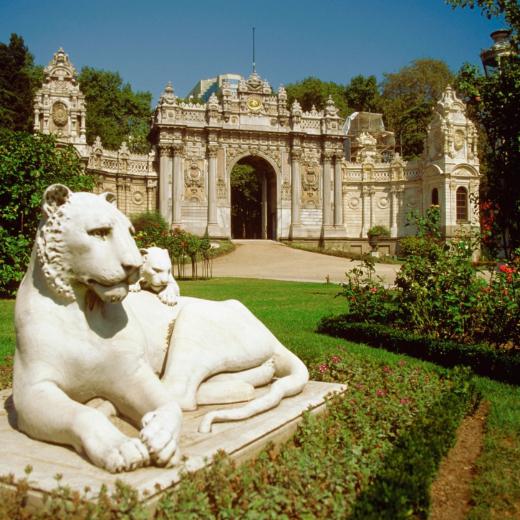Address : Dolmabahçe Palace, 34357 Beşiktaş / İstanbul
Dolmabahche Palace Istanbul as a 19th Century Palace
The coastal area of Beşiktaş, where Dolmabahche Palace Istanbul is located, is an area that has been the scene of shipping activities in the past as one of the bays of the Bosphorus. This bay, which was a natural harbor for ships to take refuge since antiquity, also attracted the rulers during the Byzantine period and royal palaces were built in this region.
The coastal area, which served as a port where navy ships were anchored and maritime ceremonies were performed during the Ottoman period, was named “dolmabağçe” after the sea was filled in the 16th century. Although the official residence was Topkapı Palace, the “dolmabağçe” region became one of the preferred places to visit and has been used as a royal garden belonging to the sultan and the dynasty. In the 19th century, the group of mansions and pavilions built on this garden were collectively called “Beşiktaş Coastal Palace”. The influence of the trend of renewal and modernization of the 19th century was also reflected in the palaces, as well as in the culture and administration of the Ottoman Empire. Dolmabahche Palace Istanbul, which has the title of being the third largest palace structure of Istanbul today, is the most magnificent work created by this trend of renewal.
The structures of Beşiktaş Coastal Palace were considered to be incomplete in terms of functionality during the reign of Sultan Abdülmecid (1839-1861). These structures were demolished and Dolmabahche Palace Istanbul was built in their place during this period. The construction of the palace started on June 13, 1843, and was completed on June 7, 1856. It is situated on an area of 110 thousand square meters, dominating the magnificent view of the Bosphorus.

Dolmabahche History
Dolmabahçe Palace, the symbol of Westernization of the 19th century, carries the memory of the centuries and the clear splendor of the waters of the Bosphorus. A bay that harbored ships since antiquity, in time it became the favorite residence of the Sultanate.
From a Bay to a Palace
The transition from Topkapı Palace to Dolmabahçe Palace in the 19th century was a radical change. The administrative center of the reign was shifting. Dolmabahçe Palace was also opening towards the new in terms of architecture. For the Ottoman Palace and society, the meaning of Dolmabahçe meant more than a palatial structure.
The area where the palace stands today has always been used as a settlement since the early ages. Its function as a harbor was transformed with the gardens and pavilions built upon it, but the region never lost the interest it has attracted. The region, that had a palace called Aya Mamas during the Byzantine period, was a strategic and popular place where states and monarchs focused on with its location, function and natural beauties.

Favorite of the Reign of Every Century
The Beşiktaş coast and its immediate surroundings continued to attract the same attention during the Ottoman period. Although its use as a center of administration by the sultanate began in the 19th century, the active use of the region by the Ottomans dates further back in the past.
From the end of the 15th century to the beginning of the 16th century the pavilion, garden and palace structures for the sultans were built in the region. These shores were significant even after the conquest of Istanbul, being the gathering point of the Ottoman navy before expeditions.
Suleiman the Magnificent (1520-1566), had built a summer palace on the hill behind the royal gardens of Beşiktaş.From Beşiktaş Coastal Palace to DolmabahçeThe oldest structure of the Ottoman Empire in the region was built during the reign of Bayezid II Period (1481-1512). Although there is no detailed information about this mansion, the interest in the region continued to increase exponentially and became more evident in the 17th century.
The concentration of palace related structures in the area, and the construction of the royal garden and the Tiled Pavilion, one of the earliest buildings of significance in the area, demonstrates that the royalty directly focused on the region.
The reign of Ahmed I (1603-1617), a sultan who enjoyed spending time here, was one of the periods in which interest in the region gained momentum. Ahmed I had the bay area extending to Levent Farm filled and built a royal garden there.
After the coastline was filled, the region became known as “dolma-bağçe”. Evliya Çelebi’s writings and the history of Naima also mention that activities such as wedding ceremonies and javelin competitions were held in the flat area formed by land reclamation during this period.
Departure from Topkapı PalaceBeşiktaş Coastal Palace, with its buildings that expanded and transformed from the 17th century until the end of the 18th century, became the second largest palace in Istanbul after the Topkapi Palace, which was the administrative center of the empire at the start of the reign of Selim III.
Beşiktaş Coastal Palace structures were deemed unsuitable for long-term accommodation, and Selim III had requested for them to be repaired. His successor Mahmut II also spent time at Beşiktaş Coastal Palace, but used Topkapı Palace as the official residence and administration center.
Following Mahmut II, Sultan Abdülmecid wanted to make new arrangements at Beşiktaş Coastal Palace and to make it suitable for long stays and for the requirements of the era.
The palace had to be completely demolished and replaced by a new one in order to achieve this. On June 13, 1843, the construction of the Dolmabahçe Palace was started, and in 1856 Sultan Abdülmecid left the Topkapı Palace to permanently settle in the Dolmabahçe Palace.
The reign of Sultan Abdülmecit (1839-1861), which coincides with the 19th century trends of reform, is a period in which the administration, functions and culture of the palace began to change as the government moved to Dolmabahçe Palace.
The principles of protocol, traditions, and even the fashions of clothing and decoration of this era began to be fused with the western styles and resemble European palaces. The increasing number of guests from Europe has facilitated and further accelerated this cultural exchange.
When Sultan Abdülmecit settled in Dolmabahçe Palace, it became the official residence and administrative center of the Ottoman Empire. After Sultan Abdülmecit 6 sultans lived in Dolmabahçe, including Sultan Abdülaziz, Sultan Murad V, Sultan Abdülhamid II, Sultan Mehmed Reşad V and Sultan VI. Mehmed Vahideddin VI, as well as the last Caliph Abdülmecid Efendi (1922-1924).
The last person living in Dolmabahçe is Mustafa Kemal Atatürk, the founder and first President of the Republic. Mustafa Kemal Atatürk lived and carried out his official works in Dolmabahçe between the years 1927-1938, and passed away there on November 10, 1938. Afterwards, İsmet İnönü continued to use Dolmabahçe as office. The palace gained a museum-palace status and was opened to visitors in 1984.
Dolmabahçe Palace, which witnessed every step of westernization efforts of the Ottoman Empire since 1856 to the declaration of the Republic in 1923, has witnessed many important reforms and revolutionary political developments since its establishment. The Alphabet Revolution, the Language Revolution, the opening of the Parliament and the congresses of history and language are some of these important political advancements.

The Architecture of the Palace
The important and famous architects of the period took part in the construction process of the Dolmabahçe Palace: Abdülhalim Bey, Altunizade İsmail Zühtü Pasha, Karabet Balyan, Ohannes Serverian, Nikoğos Balyan and James William Smith. Although the building plan does not stray from the old traditions, the interior and exterior decorations of the palace were intensively based on western styles
Dolmabahçe Palace, as a structure that emerged from the trend of renewal in the 19th century, also bears the effect of western styles in terms of architecture. Dolmabahçe Palace, which reflects Rococo, Baroque and Neo-classical architectural styles, also differs from Topkapı Palace in terms of architectural plan.
While Topkapı Palace has a design that expands and changes according to time and changing requirements, a predetermined design and plan layout has been implemented in Dolmabahçe Palace.
The main structure of the palace is functionally divided into three parts: the administrative “Mabeyn-i Hümâyûn” (Selamlık), where the governmental affairs are carried out, “Harem-i Hümâyûn” (Harem), which belongs to the private life of the sultan and his family, and the “Muayede Hall” (Ceremonial Hall) which is reserved for the important state ceremonies of the sultan.
Dolmabahçe Palace is built on 14.595 m2 area and has 285 rooms, 44 halls, 68 toilets and 6 Turkish baths, and is the largest palace in Turkey as a single monolithic structure.
From Sofa Dining to Table Top Feasts
Along with the architecture of Dolmabahçe, western influence is also visible in the interior design. The past tradition of seating arrangements with sofas and cushions were replaced by a table seating arrangement, seen as an indicator of modern living, in Dolmabahçe. The Ottoman dynasty followed and applied the thoughts and innovations of the era.
The Ottoman dynasty and society, welcoming innovations as the way of modernization and took the west as an example, experienced the western influences in the political, cultural and social spheres. Dolmabahçe Palace has a very important position in the history as a witness and perpetrator of this process. Dolmabahçe Palace has an eternal value, as one of the first monuments of modernization.

Dolmabahche Palace Istanbul Gardens
Peace of Nature in Dolmabahche Palace Gardens
Dolmabahche Palace Istanbul, which is the third largest palace in Istanbul among the palaces built in the Ottoman period, has a magnificent splendor with its gardens, as well as its historical and refined architecture indicating a turning point.
Before the construction of the Dolmabahçe Palace, the swampy bay between Beşiktaş Royal Garden and Kabataş Karabali Gardens was reclaimed by filling the sea in the 17th century.
The palace took its name from this filling process and the region was transformed into a large garden. As its name indicates, the region called “dolma-bağçe” has been associated with horticulture since then. Utilized as a royal garden for many years, Dolmabahçe gained further significance after it became the residence of the dynasty.
Located in the middle of a large and well-preserved green area on both the land and sea sides, the gardens of the Dolmabahçe Palace display a clear European influence.
Geometric arrangements of these gardens, the use of garden ponds, vases, sculptures and lanterns, and the works of foreign gardeners such as German Sester, Fritz Venze and Koch Münika from Europe, show that the gardens were created with a European garden design in mind.
The gardens of the Dolmabahçe Palace consists of 4 large sections: Hasbahçe (Selamlık), Kuşluk (the bird garden), Harem and the Crown Garden. These gardens are positioned and classified according to the function of the buildings around them.
Rare plants from Asia, Europe and America have been selected and brought for the arrangement of the gardens, creating a splendid collection.
Refrence : https://www.millisaraylar.gov.tr/

